Written by Reshma Kotwal
I have a bad case of the butterflies. It isn’t just the turbulence. I’m headed to Goa for the first contact period of the LEC course. Despite my background in education, I’ve never engaged directly with children, not even in a classroom let alone a library. This is terra incognita — uncharted territory.
I’m glad to have Swati from the LEC 2024 cohort for company. Driving through picturesque roads, we arrive at the venue — The Bambolim Beach Resort — and are greeted by a vast expanse of sea. Strolling along the lovely promenade, we see Bookworm team members flitting busily in and out of a hall overlooking the shore. We try to sneak a peek but are thwarted.
Later that evening, Swati and I meet the rest of the cohort. Among us are teachers from mainstream and alternative schools, librarians, educators working with non-profits, entrepreneurs, and some looking to pivot careers. Wide-ranging conversations spark over dinner, setting the tone for the week ahead. It feels surreal to be surrounded by so many folks with a passion for spreading bookjoy.
The next day, there’s an air of eager anticipation at breakfast too. Finally, the doors to the hall open, and it’s show time! As we enter, a collective murmur breaks out. The drab hall has been transformed into a lively, atelier-like space.
Two large displays on — “Water” and “Food” — immediately catch the eye. Arranged along the sea-facing window, the tables for the “Water” display are draped in various shades of blue and adorned with seashells, a dried coconut shell, a miniature boat, and other bric-a-brac. Interspersed between these artefacts are some lovely books: “Sea Prayer,” a tribute to refugees journeying across treacherous seas; “Tsunami,” a Patua-style scroll book; and “An Indian Beach,” a picture book with an unusual flexible form. A box of indigo inks and canvas rectangles invite us to indulge in art play, inspired by the sea and sky.
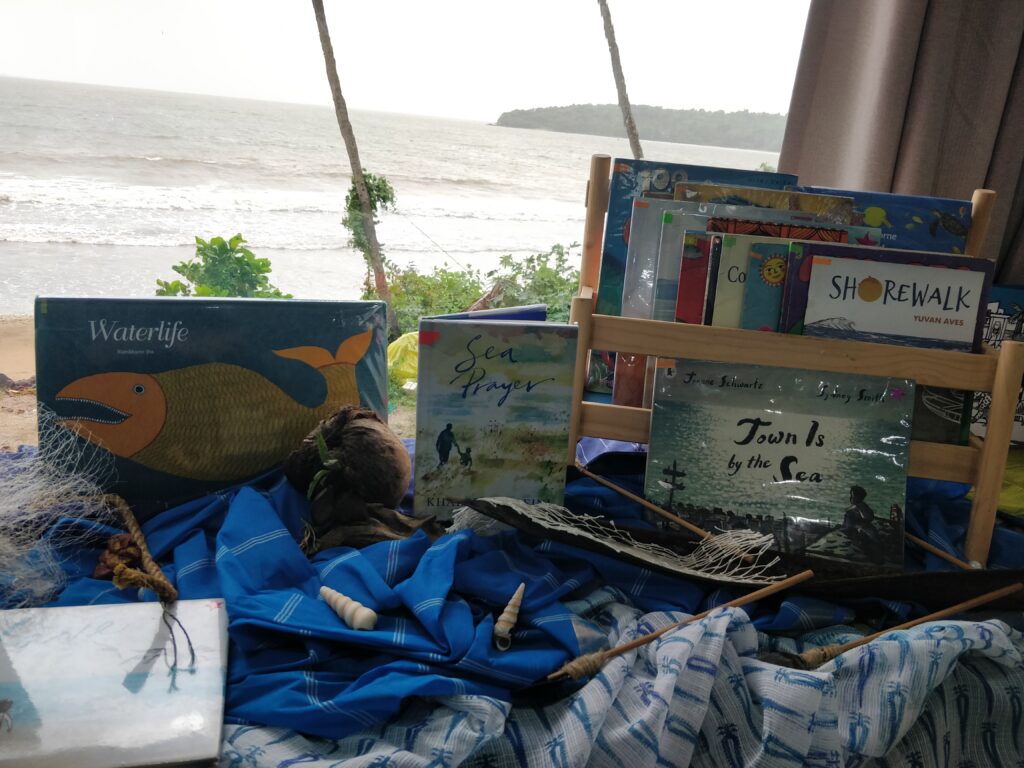
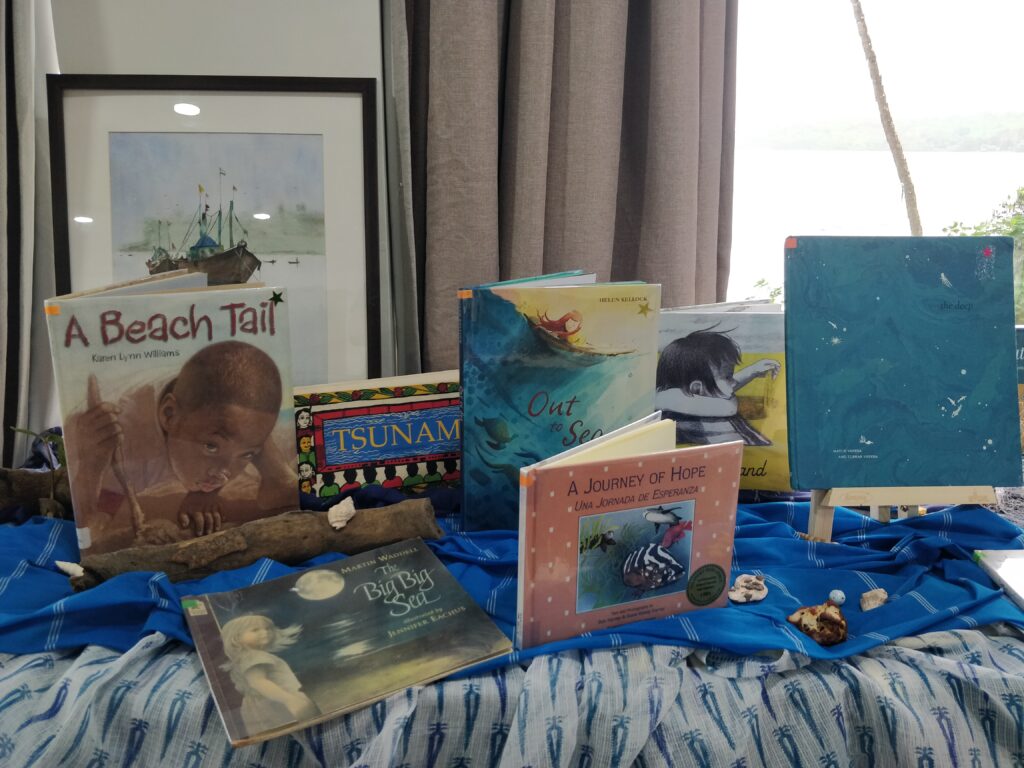
Running down the opposite wall, the “Food” display tables, clad in turmeric yellow, are a veritable smorgasbord for the senses. There are peanut puranpolis to taste, dried fish to smell, rice grains and beans to feel, and a string of red chillies for a dash of colour. Carefully chosen objects complement the showcased books — a kettle alongside “Noon Chai,” a grinding stone next to “Grinding Stories Retold,” and a chulha adjacent to “Head Curry” — deepening the sensory engagement with the stories they tell.
In one corner of the hall, shelves display a selection of books from Bookworm’s vast collection. These have been curated to give us a sense of diverse themes (primarily, libraries, childhoods, and identities), genres (such as biographies, historical fiction, folktales, and poetry), and formats (picture books, accordions, graphic novels, etc.). A cozy tent (fashioned out of a saree) beckons us to curl up with a book and enjoy some quiet reading time. At the far end, counters hold stationary and, surprisingly, stitching supplies. Tucked in between are interactive stations for introducing ourselves, dabbling in blackout poetry, parking our questions, and posting reflections.
Reigning in our impulse to explore, we focus on the agenda. The day kicks off with a mimed adaptation of the book “The Librarian from the Black Lagoon,” the first of many creative pedagogical techniques modelled by the Bookworm team. Over the next few days, we are enraptured by a delightful read aloud, nudged to think critically and examine biases by insightful book talks (never thought food could be a hot-button topic!), and roused to curiosity by dramatic character roleplays.
After the theatrical opening, the next session takes an unexpectedly calm turn. We are introduced to stitching as a mindfulness practice. “Yikes,” I groan inwardly. With patient guidance from Bookworm team members and more than a little help from friends, I overcome my initial reluctance and make a tentative start.
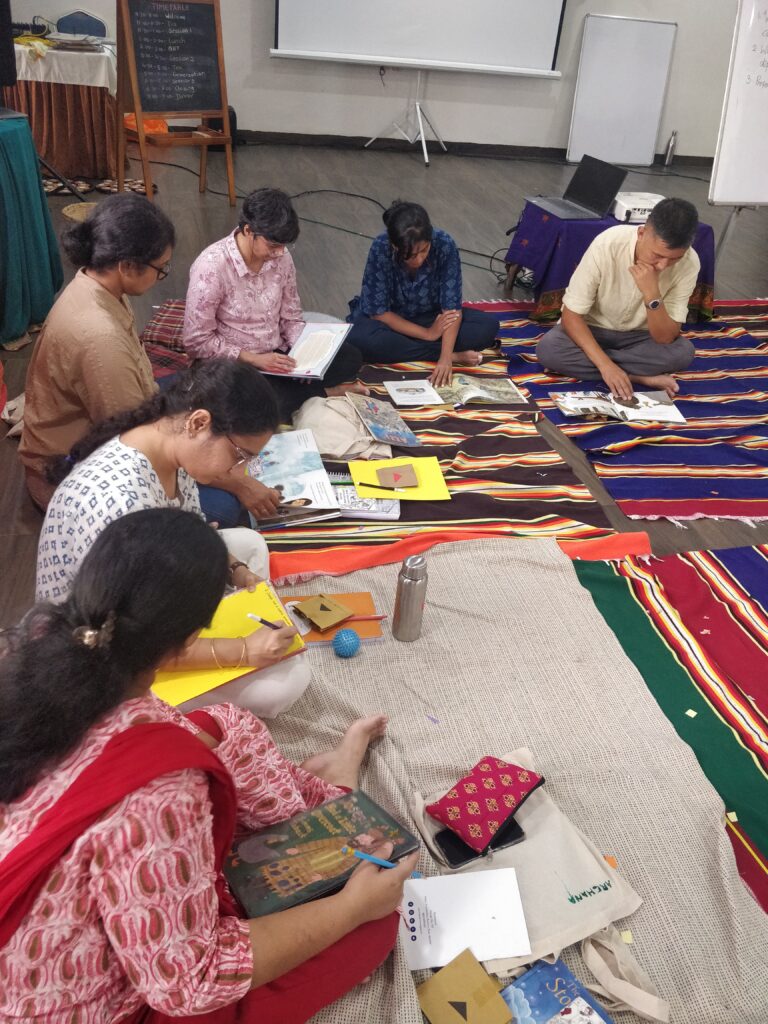
Emboldened by the gentle facilitation and warm camaraderie that develops over the week, I subsequently shed many more inhibitions — painting, playing games, dancing, and even sashaying (ahem!) down a makeshift catwalk with joyful abandon.
As I dwell on the first day’s proceedings in my journal, I reflect on how space, interactions, and activities influence the reader experience in a library. Slowly, the abstract idea of a library as a multidimensional, experiential place begins to take concrete form.
This idea becomes clearer when we visit the Bookworm library in Mala. The aesthetics of the space mirror the ethos of the library it houses. With its meticulously organized bookshelves, reading nooks, thematic displays, and walls adorned with children’s artwork, the heritage building is testimony to Bookworm’s commitment to striving for human wholeness through engagement of the head, heart, and hands.
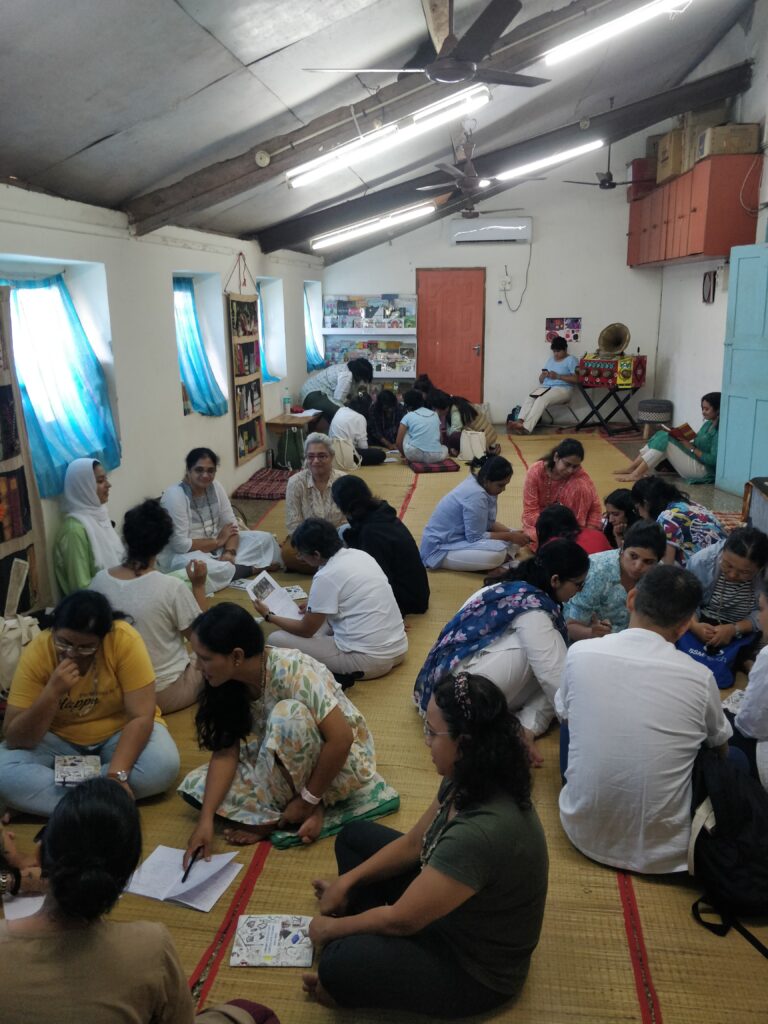
On the bus back to the resort, I wonder how this experience may be replicated in smaller, less-equipped spaces. My question is answered the next day when a group of us visit Bookworm’s community site in Cacra. A vibrant, wall-height mural illuminates the small room. We observe the children banter with the facilitator, engage in quiet reading, journal about their day, participate in games, enjoy a read aloud, and borrow books. The site is a microcosm of the larger library, underscoring that it is lack of vision, not space, that plagues our children’s libraries.
Reflecting on the field visits, I recall the reading histories we discussed earlier. I am reminded of the words of Nan Shepherd, the Scottish mountaineer and poet, who described this intimate relation between a physical place and a person as one in which “place and a mind may interpenetrate till the nature of both is altered.”
On the last day of the contact period, I feel a sense of accomplishment as I look at my completed sewing patch. The needlework isn’t great, but each element is personally meaningful and together they tell the tale of my journey of discovery in Goa:
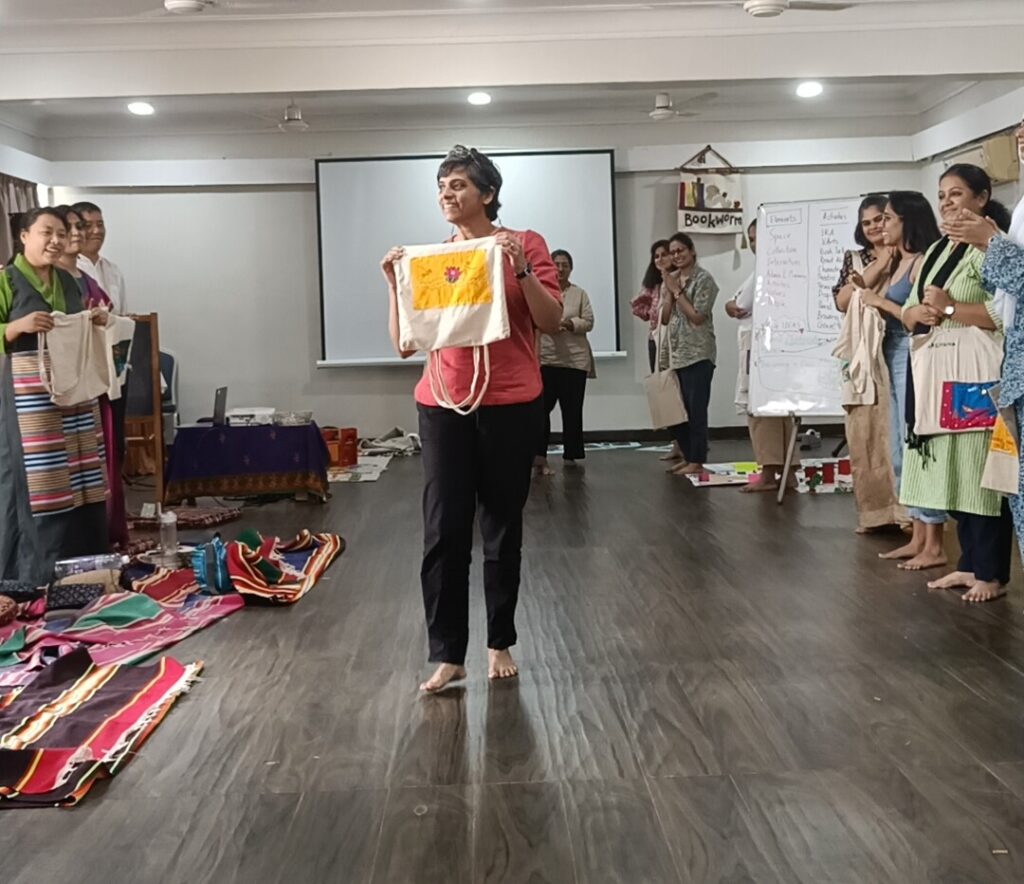
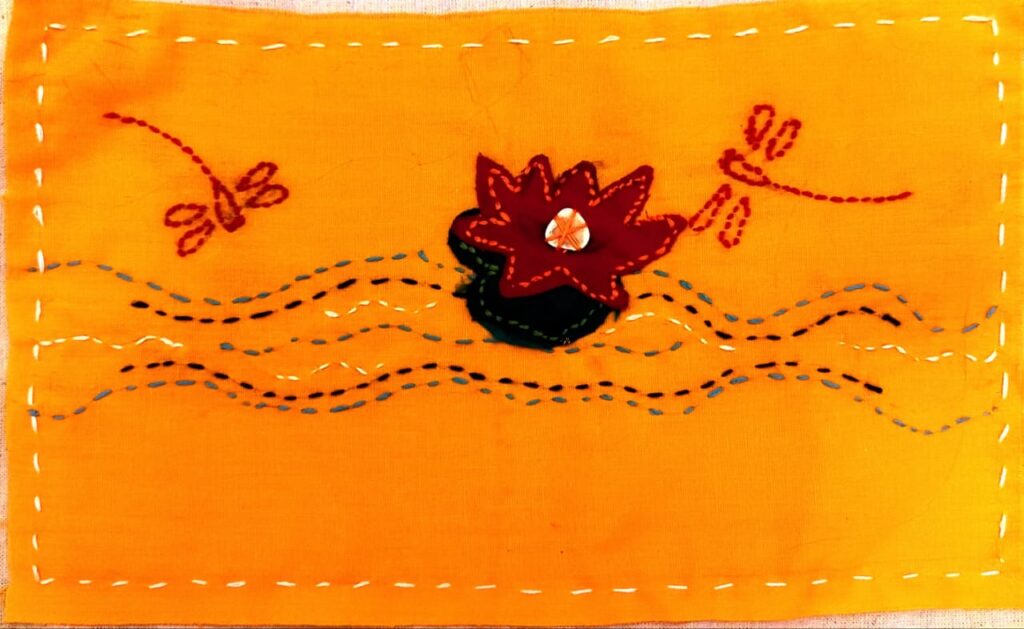
Under the sun’s gaze
Dragonflies dance to the wind
A lotus unfolds
Joy and hope in each slow step
Reveal secrets of the heart
I feel buoyant as I board the flight home. It’s a lightness that comes from having glimpsed the possibilities and voyaging towards their realisation with a collective of bravehearts, guided by able stewards.
Thank you, Bookworm, for opening your doors to us and generously sharing so much bookjoy.
Annotations
Sea Prayer – Author: Khaled Hosseini, Illustrator: Dan Williams.
Tsunami – Author and Illustrator: Joydeb Chitrakar and Moyna Chitrakar
An Indian Beach: By Day and Night – Author and Illustrator: Joelle Jolivet
Noon Chai – Author: Adithi Rao, Illustrator: Ghazal Qadri
Grinding stories Retold– Written by varied authors, Translated by Heta Pandit
Head Curry- Author: Mohd Khadirbabu, Translator: A. Suneetha, Illustrator: Gulam Mohammed Shaikh
The Librarian from the Black Lagoon- Author: Mike Thaler, Illustrator: Jared Lee
